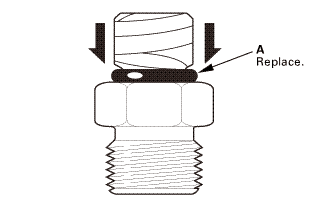Honda Civic Service Manual: Manual Shut-off Valve Removal and Installation (R18A9)

| 1. | Vehicle Lift |
|
| 2. | Fuel Pressure - Relieving (Between the fuel tank and the engine) (Natural Gas Model) |
|
|
Compressed natural gas is flammable and highly explosive. You could be
killed or seriously injured if leaking natural gas is ignited.
|
| 3. | Rear Floor Undercover (Natural Gas Model) |
|
|
|
| 4. | Manual Shut-off Valve (Natural Gas Model) |
|
|
|
|||||||||

| 1. | Fuel Pipe Connector O-Ring (Natural Gas Model) |
|
|
|
||||||
|
|
|
||||||||||||
| 2. | Manual Shut-off Valve (Natural Gas Model) |
|
|
|
||||||||||||
| 3. | Rear Floor Undercover (Natural Gas Model) |
|
|
|
| 4. | Fuel Supply System Leak - Inspection (Natural Gas Model) |
|
|
|
|
|
|
|
|
|
 Fuel Supply System Leak Inspection (R18A9)
Fuel Supply System Leak Inspection (R18A9)
Inspection
Compressed natural gas is flammable and highly explosive. You could be killed
or seriously injured if leaking natural gas is ignited.
Stop the engine, and keep heat, sparks, and fla ...
 Fuel Filter A Removal and Installation (R18A9)
Fuel Filter A Removal and Installation (R18A9)
Compressed natural gas is flammable and highly explosive. You could be killed
or seriously injured if leaking natural gas is ignited.
Stop the engine, and keep heat, sparks, and flames away.
...
See also:
Honda Civic Service Manual. Front Grille Removal and Installation ('12, '13: 2-door,
'14: 4-door)
1.
Front Bumper
1.
Remove the screws (A), the bolts (B),
and th ...








 ioumm
ioumm

